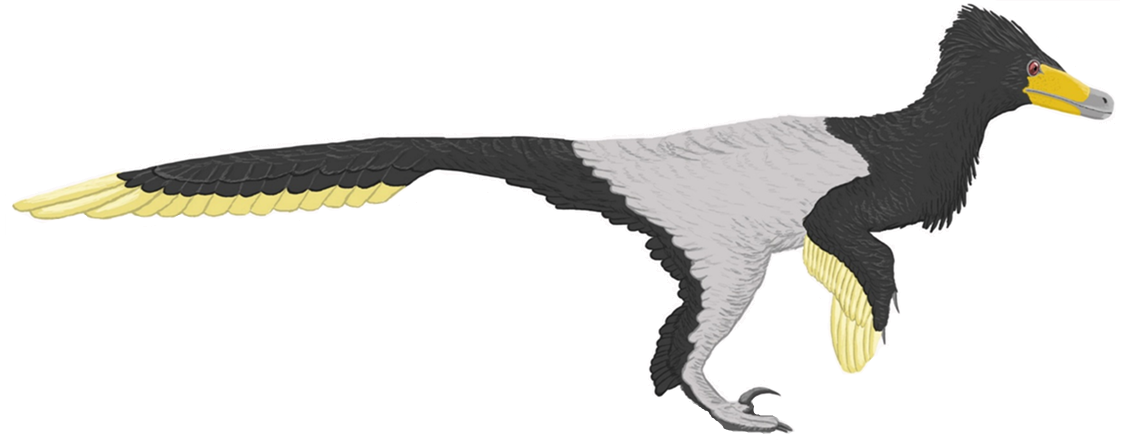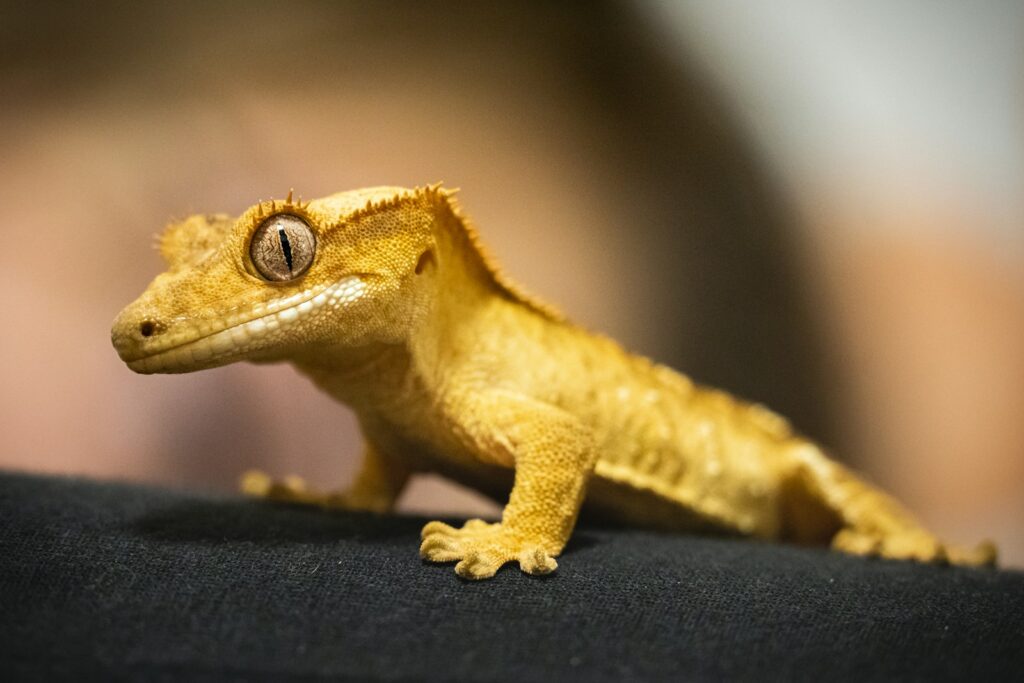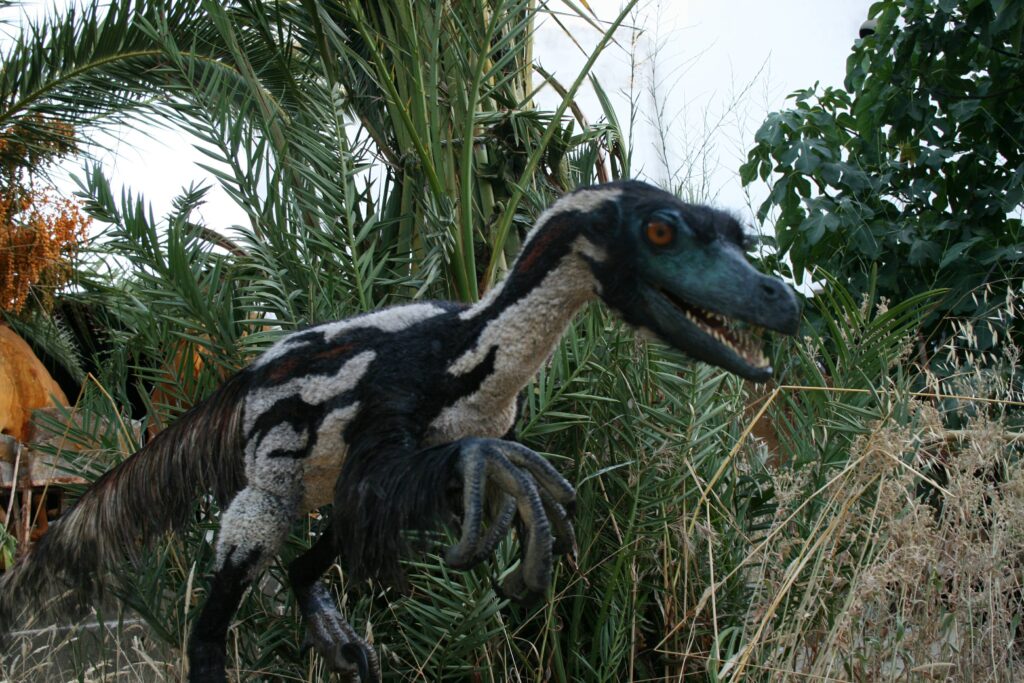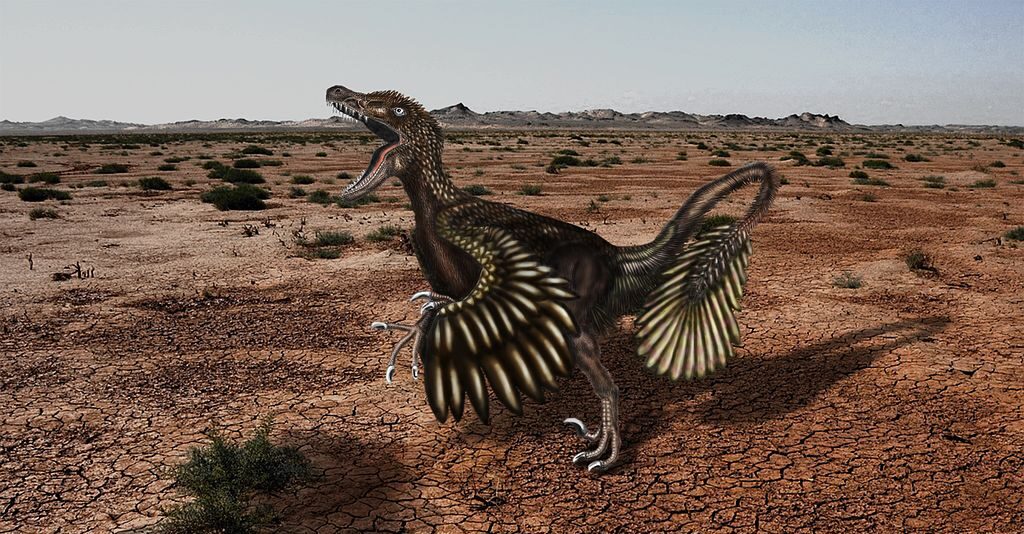When “Jurassic Park” roared onto screens in 1993, it forever shaped how the public imagined velociraptors – as human-sized, intelligent predators with scaly skin and terrifying hunting abilities. These creatures became cinema icons, stalking through kitchens and outsmarting humans with almost supernatural intelligence. However, paleontological discoveries have revealed a dramatically different picture of what these fascinating dinosaurs actually looked like and how they behaved. The Hollywood version, while undeniably exciting, bears little resemblance to the scientific reality. From size and body covering to posture and behavior, almost everything we thought we knew about velociraptors thanks to popular media requires significant revision. Let’s explore what these fascinating prehistoric creatures really looked like, based on the latest fossil evidence and scientific research.
The True Size of Velociraptors: Much Smaller Than You Think

Perhaps the most striking difference between Hollywood velociraptors and real ones was their size. The movie monsters stood about 6 feet tall and were roughly human-sized, making for dramatic face-to-face encounters with the human characters. In reality, Velociraptor mongoliensis was much smaller – standing only about 1.6 feet (0.5 meters) tall at the hip and measuring approximately 6.8 feet (2 meters) in length from snout to tail tip. Most of this length came from their long, stiffened tails that helped them balance. Weight estimates put the average adult velociraptor at around 33 pounds (15 kilograms) – roughly the size of a modern turkey or medium-sized dog. This dramatic size difference means that real velociraptors would have barely reached an adult human’s knee, significantly less intimidating than their silver screen counterparts.
The Deinonychus Confusion: The Real Star Behind Jurassic Park

Interestingly, the creatures depicted in “Jurassic Park” weren’t actually meant to be accurate Velociraptors at all. Michael Crichton, the author of the novel that inspired the film, based his “velociraptors” primarily on Deinonychus antirrhopus, a larger dromaeosaurid dinosaur that lived in North America during the Early Cretaceous period, about 115-108 million years ago. At the time Crichton was writing his novel, some paleontological classifications grouped Deinonychus within the Velociraptor genus, which likely influenced his decision to use the shorter, more dramatic name “velociraptor” instead. Deinonychus was indeed larger than Velociraptor, standing about 3.3 feet (1 meter) tall at the hip and measuring up to 11 feet (3.4 meters) long. However, even Deinonychus was still significantly smaller than the movie monsters and lacked many of the physical features depicted in the films.
Feathers, Not Scales: The Bird-Like Covering of Velociraptors

Perhaps the most dramatic difference between Hollywood’s portrayal and scientific reality is that velociraptors were covered in feathers, not scales. Multiple fossil specimens of velociraptors and their close relatives have preserved clear evidence of feather attachments along their arms and bodies. These weren’t just simple downy coverings but complex feather structures similar to modern birds. The evidence for feathered velociraptors is so strong that paleontologists now confidently depict them with a full covering of plumage. These feathers likely served multiple purposes, including insulation for temperature regulation, display for mating purposes, and possibly to help shield nests while brooding eggs. The feathered appearance would have made velociraptors look much more like strange, toothy birds than the reptilian monsters portrayed in films.
Proper Posture: How Velociraptors Actually Stood

Hollywood velociraptors are typically portrayed with a horizontal posture, their spines parallel to the ground as they sprint after prey. While this makes for dramatic chase sequences, it’s another area where scientific accuracy was sacrificed for cinematic effect. Based on skeletal anatomy, real velociraptors likely held their bodies in a more bird-like posture, with their torsos angled somewhat upward rather than perfectly horizontal. Their long tails would have served as counterbalances, helping maintain balance during quick movements and turns. The positioning of the hip socket and leg bones indicates that velociraptors moved more like modern ground-dwelling birds than like crocodilians. This posture, combined with their feathered appearance, would have given them a much more avian look than the reptilian stance depicted in popular media.
The Famous Sickle Claw: A Deadly Reality

One feature that Hollywood got partially right was the velociraptor’s most famous weapon – the enlarged, sickle-shaped claw on the second toe of each foot. This distinctive feature was indeed present in real velociraptors, measuring up to 3 inches (7.6 centimeters) along the outer curve in adults. However, how this claw was used has been subject to evolving scientific understanding. Rather than slashing open prey’s bellies as dramatically depicted in films, biomechanical studies suggest the claw was more likely used to puncture and grip, helping to pin down smaller prey while the jaws delivered killing bites. The raptors may have used a technique more similar to modern birds of prey, pouncing on victims and using these claws to prevent escape while they delivered multiple bites with their toothed jaws. This hunting method would have been effective but quite different from the dramatic disemboweling scenes portrayed on screen.
The Reality of Velociraptor Intelligence

Jurassic Park’s velociraptors were portrayed as almost superhumanly intelligent, capable of complex problem-solving, advanced pack hunting, and even opening doors. While real velociraptors were relatively intelligent for dinosaurs, their cognitive abilities have been significantly exaggerated in fiction. Brain endocasts (molds of the interior brain cavity) from velociraptor skulls suggest they possessed intelligence roughly comparable to modern birds like pheasants or chickens – not the near-human reasoning shown in films. They would have been capable of learning, adaptation, and some level of social behavior, but nothing approaching the calculated hunting strategies depicted in movies. Their brain-to-body ratio was larger than many other dinosaurs, suggesting higher intelligence than some of their contemporaries, but still within the range of modern reptiles and birds rather than approaching mammalian levels.
Hunting Habits: Solitary or Pack Hunters?

One of the most terrifying aspects of movie velociraptors is their coordinated pack-hunting behavior, working together to bring down much larger prey. However, the evidence for pack hunting in velociraptors remains limited and subject to scientific debate. While some fossil sites show multiple dromaeosaurid specimens preserved together, these could represent animals that died together for various reasons rather than evidence of coordinated hunting. Some modern predatory birds do hunt cooperatively in certain circumstances, which could support the possibility of social hunting in their dinosaur relatives. However, the complex, militaristic coordination depicted in films goes far beyond what the fossil evidence supports. Velociraptors may have occasionally hunted in loose groups, particularly for larger prey, but they were likely as capable of solitary hunting as many modern predators are.
Habitat and Geographic Range: Where Velociraptors Actually Lived

While the film franchise has placed velociraptors in various settings around the world, the real Velociraptor mongoliensis had a much more limited geographic range. Fossils of true velociraptors have only been found in Central Asia, specifically in what is now Mongolia and northern China. During the Late Cretaceous period (approximately 75-71 million years ago), these areas were very different from today, consisting primarily of arid environments with sandy, stream-laced plains rather than the lush forest settings often depicted in films. This semi-arid environment would have supported a different ecosystem than the jungle settings commonly portrayed in velociraptor media. The related Deinonychus lived in North America in somewhat earlier times (about 115-108 million years ago), in what is now the western United States, in more forested environments that may have more closely resembled some of the movie settings.
Velociraptor Prey: What Was Actually on the Menu

Hollywood velociraptors are shown attacking prey much larger than themselves, including adult humans and even large dinosaurs. The reality of velociraptor diet was likely quite different, constrained by their smaller size and physical capabilities. Based on their anatomy and occasionally preserved stomach contents, real velociraptors likely preyed primarily on small to medium-sized animals that they could overpower, including small mammals, lizards, and smaller dinosaurs. One famous fossil discovery actually shows a Velociraptor locked in combat with a Protoceratops (a sheep-sized relative of Triceratops), suggesting they did sometimes tackle prey close to their own size. Their diet was probably supplemented with scavenging when opportunities arose. The famous sickle claw and serrated teeth would have been effective tools for subduing smaller prey, but the idea of velociraptors regularly hunting large dinosaurs many times their size is not supported by the evidence.
Velociraptor Vocalization: No Screeching or Roaring

The chilling screeches and roars of movie velociraptors have become iconic sounds in cinema history, but they bear little resemblance to the sounds real velociraptors likely made. Based on their closest living relatives (birds), velociraptors probably couldn’t roar at all. Birds produce sounds using a syrinx rather than a larynx, and the structure of velociraptor throats suggests they lacked the vocal equipment needed for mammalian-style roaring. Instead, they likely made sounds more similar to modern birds – perhaps hisses, clucks, croaks, or calls that might sound somewhat like those of modern birds of prey. Some scientists have suggested they might have made closed-mouth vocalizations similar to the booming sounds produced by modern cassowaries and emus. While certainly not silent, real velociraptors would have sounded much more bird-like than the terrifying movie monsters with their reptilian roars.
Velociraptor Relatives: A Diverse Family Tree

While “Jurassic Park” focused on Velociraptor as its signature small predator, these dinosaurs were just one member of a diverse family of similar dinosaurs called dromaeosaurids, colloquially known as “raptors.” This family included numerous genera varying considerably in size and proportions. Microraptor, one of the smallest, was just 2.6 feet (77 cm) long and had four wings, strongly suggesting it could glide or even fly. At the other end of the spectrum, Utahraptor was truly formidable, reaching lengths of 23 feet (7 meters) and weighing over 1,100 pounds (500 kg) – much closer to the size of movie velociraptors than the real thing. Other notable members included Deinonychus (as mentioned earlier), Dakotaraptor, and Achillobator, all of which shared the distinctive sickle claw and feathered bodies. This diversity shows that the raptor family was highly successful, adapting to various ecological niches across the Northern Hemisphere during the Cretaceous period.
Modern Birds: The True Living Velociraptors

Perhaps the most profound revelation about velociraptors is that they haven’t entirely disappeared – in a very real sense, they live on in modern birds. The evolutionary relationship between dromaeosaurid dinosaurs like Velociraptor and modern birds is now well-established through multiple lines of evidence, including skeletal features, egg-laying behavior, feather structure, and molecular data from preserved proteins. Birds are not merely similar to dinosaurs; they are literally living theropod dinosaurs, having evolved from the same group that included velociraptors. This means that when you watch a chicken scratching in a yard or an eagle soaring overhead, you’re observing the modified descendants of dinosaurs that once shared the planet with Velociraptor. Many of the features we now know velociraptors possessed – from feathers to wishbones to specific nesting behaviors – make perfect sense when we understand them as part of the evolutionary lineage that eventually led to modern birds.
Scientific Accuracy in Media: Why Hollywood Takes Liberties

Given what we now know about real velociraptors, why did filmmakers choose to depart so dramatically from scientific accuracy? The answer lies in the need for storytelling versus scientific precision. When “Jurassic Park” was being developed in the early 1990s, some of our current knowledge about velociraptor appearance (particularly regarding feathers) was not yet established. However, even with the information available at the time, many creative decisions were made to enhance dramatic effect rather than accuracy. Larger, more reptilian predators simply made for more terrifying antagonists than turkey-sized feathered creatures. The film’s velociraptors needed to pose a clear physical threat to human characters and create tension through eye-to-eye confrontations. Additionally, the sleek, scaly appearance fits better with the audience’s expectations of what dinosaurs should look like. While later films in the franchise have acknowledged some of these inaccuracies through dialogue, they’ve largely maintained the established design for consistency and audience recognition.
The gulf between Hollywood’s velociraptors and their real-life counterparts provides a fascinating case study of how scientific understanding evolves and how popular culture can both help and hinder public understanding of prehistoric life. The real Velociraptor mongoliensis may not have been the towering, scaly monster depicted in films, but the truth – a swift, feathered predator with remarkable adaptations and evolutionary connections to modern birds – is arguably even more fascinating. As our knowledge continues to grow through new fossil discoveries and analytical techniques, our picture of these ancient animals becomes increasingly detailed and nuanced. Perhaps the most important takeaway is that while Hollywood’s interpretation sparked widespread interest in these dinosaurs, the scientific reality offers a window into an ancient world more complex and surprising than any fiction could invent.



